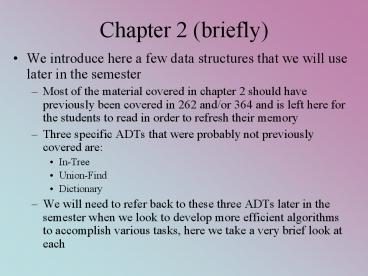Chapter 2 briefly - PowerPoint PPT Presentation
1 / 6
Title: Chapter 2 briefly
1
Chapter 2 (briefly)
- We introduce here a few data structures that we
will use later in the semester - Most of the material covered in chapter 2 should
have previously been covered in 262 and/or 364
and is left here for the students to read in
order to refresh their memory - Three specific ADTs that were probably not
previously covered are - In-Tree
- Union-Find
- Dictionary
- We will need to refer back to these three ADTs
later in the semester when we look to develop
more efficient algorithms to accomplish various
tasks, here we take a very brief look at each
2
The In-Tree (2.3.5)
- An In-tree is a tree with only one kind of access
from child to parent or from descendant to
ancestor, but not from ancestor to descendant as
we have in a normal tree - An ancestor is a node in the path from a given
node to the trees root, a descendant is a node
in the path from a given node to a leaf in the
nodes subtree - The ADT will require methods to
- makeNode (this creates a root node)
- isRoot (boolean)
- parent (returns a pointer to the parent of the
current node) - setParent (given two nodes, makes one the parent
of the other) - nodeData (returns the data stored in the current
node) - setNodeData (changes the data stored in the
current node) - In an in-tree, new nodes are not added at the
leaf, but instead the tree is extended upwards
creating a new parent to a given node
3
Example In-Tree
- Two in-trees are given to the left
- We might traverse such a tree by following an
array that stores pointers to each node - so for instance, we have A5 points to F
- We then traverse the nodes parent pointer until
we reach the root - a root node will have a designator such as parent
-1 - To add to a tree, we use setParent
- As in setParent(G, A) which creates the subtree
below on the left
G
I
H
J
4
Union-Find ADT (2.5.2)
- The Union-Find ADT consists of a data structure
that includes a number of sets and two methods - Union take two distinct sets and create a
single set that combines all elements of the two - Find a boolean operation to determine if two
items are in the same set or not - Two other methods that we might want are
- Create create a new Union-Find structure with n
initial empty sets - makeSet initializes the empty sets to contain a
single element
5
Union-Find Example
- Consider the following
- UnionFind uf new UnionFind()
- uf.create(10) // creates a structure with 10
initial empty sets - uf.makeSet(a, 1) // makes the first set a
- uf.makeSet(b, 2) // makes the second set b
- uf.makeSet(c, 3) // makes the third set c
- uf.union(1, 2) // unions the two sets to be a,
b - uf.find(1, 2) // returns 1 or 2, whichever is
the int value that now represents the single set
of two items - uf.find(1, 3) // returns 0 (1 and 3 are not in
the same set)
6
Dictionary ADT (2.5.3)
- Like a true dictionary, there are entries that
are indexed by an identifier and store
information about that entry, but they need not
be used to store say pronunciation and definition
as with a true dictionary - The dictionary type can store anything that we
want to have associated with the identifier - In a way, the dictionary ADT is much like a
database a unique key (the identifier) is used
to access the information pertaining to that key - Methods will include
- Create to create a new dictionary
- Member boolean to determine if the parameter is
in the dictionary - Retrieve to retrieve the object that is
identified by the parameter - Store to add a new object in the dictionary
given the identifier and the object (storage
information)































